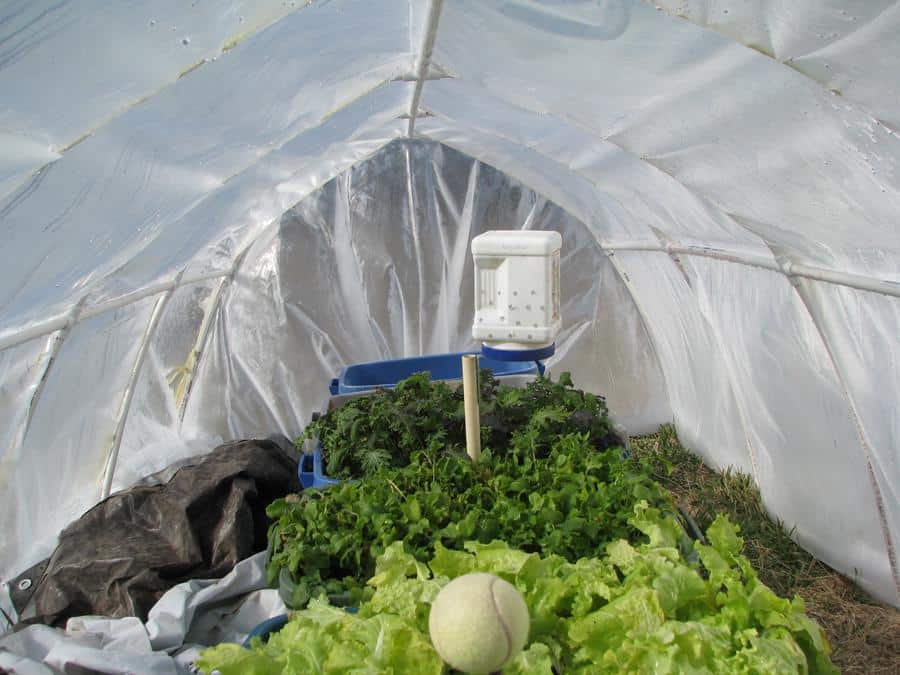Growing your own food moves you one step closer to the goal of self-sufficiency, but Jack Frost’s freezing winter temperatures hinder such efforts.
This year, why not build a cheap survival mini-hoop house and realize your independent objective of raising winter greens?
Most hoop houses are walk-in arched structures with plastic sheeting covering steel conduit frames. Smaller crawl-in mini-hoop houses usually contain white PVC pipe ribs. The problem: Heavy winter snowfall collapses these plastic ribs. One solution is to add purlins, or horizontal wooden 1x2s, connecting and supporting the ribs.
An even better idea is producing mini-hoop house PVC framing that has 2½-foot squares built into the structural integrity of the framework, a vast improvement over single PVC ribs. It’s done by inserting 4-way PVC connectors in three places every 2½ feet along middle ribs. PVC tees are used similarly in two ribs that will be at the ends of your new mini-hoop house. Then, 2½-foot PVC pipe connects horizontally, between 4-way interior connectors and to the tees on the two end ribs. The final 10-foot-long PVC frame involves five hooped ribs with horizontal PVC pipe halfway up each side and on the very top. It holds up to winter snow loads.
Looking For Non-GMO Squash Seeds? Get Them From A Company You Can Trust!
To build this mini-hoop house:
Shopping List – Purchase the following, inexpensively, from any home building supply store:
- 6 — ½-inch PVC tees
- 9 — ½-inch PVC four-way connectors
- either 16 5-foot, or 8 10-foot lengths of ½-inch PVC pipe
- PVC pipe cleaner & PVC cement
- 20-foot length of ½-inch rebar (use a hacksaw in the building supply parking lot and saw it into 4-foot lengths to fit inside your vehicle)
- 150-foot length of ¼-inch polypropylene or nylon rope
- 12-foot by 25-foot roll of 4-mil clear plastic sheeting
- 22 8-inch wide by 16-inch long by 3-inch high cement blocks to hold down your plastic sheeting
Saw PVC Pipes & Rebar
Saw your PVC pipe, with a power saw, or a crosscut handsaw, into 32 2½-foot lengths. Hacksaw the ½-inch rebar into 10 2-foot lengths.
Construct PVC Hoop House Frame
Make your two end ribs first. Rub the cotton dauber found in your PVC pipe cleaner on the outside of the last half inch of one 2½-inch length of PVC pipe and inside a PVC tee. Apply PVC cement on these same surfaces and immediately slide the pipe and the tee together. Use the same procedure to connect pipes and tees, positioning all tees to face in the same direction. The resulting 10-foot-long rib contains four pieces of 2½-foot pipe connected with three tees. This rib will be at the end of your mini-hoop house frame. Make another rib in the same manner. Then, make three middle ribs, but use 4-way connectors, instead of tees. Again, make sure all 4-ways are positioned the same direction. Lay your five ribs 2½ feet apart on a flat surface, with your two end ribs on each end of your five ribs and three middle ribs in between. Now, cement 12 2½-foot PVC pipes between tees on the end ribs to the 4-way connectors on the next middle ribs, and between the 4-ways on the middle ribs.
Rebar Supports
Hammer five rebar pieces into the ground at a slight angle toward what will be the inside of the hoop house. Leave about four inches above ground. Place each rebar in a straight line exactly 2½ feet apart. Using your new framework as a guide, place the next five rebar pieces in a parallel line that is six feet away from the first line of rebar stakes, driven at a slight inward angle.
Arched Framework
Slide the ends of your ribs over your rebar supports on one side. Then, slide the other end of your ribs over their corresponding rebar supports.
Build Tie-Downs
Cut eight 15-foot lengths of rope and heat the ends with matches or a propane torch so they don’t unravel. Cut two 3-foot lengths, heating their ends, too.
Plastic Tied & Weighed Down
Pull the plastic sheeting over your arched frame. Trim it, leaving two feet extending onto the ground on all sides. Secure your tie-downs over the top of the plastic, on either side of each rib, tying each end to an appropriate rebar support. Gather the plastic on the two hoop house ends and tie your three-foot rope around this twisted-together piece of plastic. Use three cement blocks per end to weigh down plastic lying on the ground, and two blocks on the ground between each rib down each side.
Critics will advise building a door into one end, attaching ribs to a raised-bed wooden structure, using UV-protected plastics, or 6-mil plastic sheeting. These are all great ideas, but cost more money. This is the cheapest mini-hoop house design that stands up to winter’s winds and snow—a perfect solution for any homesteader.
What advice would you add on building a mini-hoop house? Share your tips in the section below:
Bust Inflation With A Low-Cost, High-Production Garden. Read More Here.
